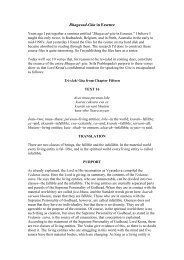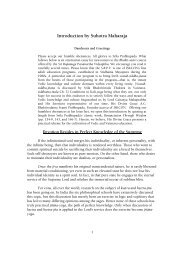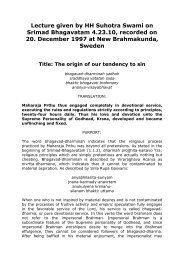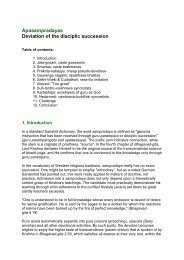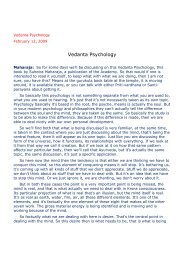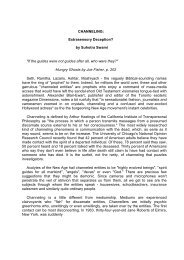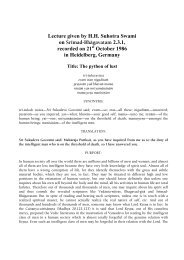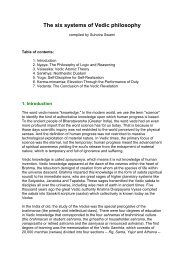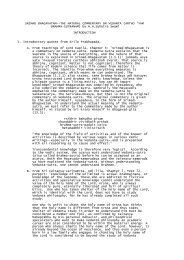Danda 1995 - Suhotra Maharaja Archives
Danda 1995 - Suhotra Maharaja Archives
Danda 1995 - Suhotra Maharaja Archives
- No tags were found...
Create successful ePaper yourself
Turn your PDF publications into a flip-book with our unique Google optimized e-Paper software.
two years old and under, in accordance with the time he had learned from theMagi."(Matthew 2:16).This last sentence then rather seem to indicate that Jesus must have been bornat least within the last two years of Herod's reign which would place his birthat 5 or even 6 BC. Consequently he either died in 28 or 27 BC with 33 years ofage according to Hippolytos' estimate of Jesus' age at crucifixion or with 35years if we are to maintain with Hippolytos the date of Crucifixion as Friday,the 14th of Nisan (A.D.29). Whichever way we are to decide, in any case thepresent choice of the date of birth of Jesus as the beginning of the Christianera is by all accounts out of question and totally arbitrary.2. The Census of QuiriniusIf you try to determine the date of Jesus on the basis of the famous statementin Luke, namely that Joseph, Mary and Jesus went to Bethlehem to attend theCensus of Quirinius, you open yet another Pandora's box: "... In those daysCaesar Augustus issued a decree that a census should be taken of the entireRoman world. (This was the first census that took place while Quirinius wasgovernor of Syria.) And everyone went to his own town to register. So Josephalso went up from the town of Nazareth in Galilee to Judea, to Bethlehem thetown of David, because he belonged to the house and line of David. He wentthere to register with Mary, who was pledged to be married to him and wasexpecting a child. (Luke 2:1-5)The fact is that Quirinius was not the Governor of Syria at that time (he wentas a Legate to Syria only as late as 6 A.D. The Governor was Varus.3. The StarIf you try to do the same by using the star of Bethlehem, more trouble isahead. Whatever may be the case, the first part of Matthew, the report on theMagi from the East, following a star in the sky, has attracted the attention ofastrologers of all times.The German Astrologer Johannes Keppler observed on December 17th in 1603 aconjunction of Saturn and Jupiter in the constellation of Pisces. He recordedthe same event in 6 B.C. and calculated that a similar constallation must haveoccured at 7 BC. Keppler found support for his theory in a jewish rabbinicalreference to the Messiah appearing when Saturn and Jupiter were in conjunctionin the constallation of Pisces. Churchfather Origen was of the opinion, that thestar of Bethlehem was actually a comet. Origen writes:..."The star that was seen in the east we consider to have been a new star,unlike any of the other well-known planetary bodies, either those in thefirmament above or those among the lower orbs, but partaking of I the the natureof those celestial bodies which appear at times, such as comets, or thosemeteors, which resemble beams of wood, or beards or wine jars or any of thosenames by which the Greeks are accustomed to describe their varying appearanccs.And we establish our position in the following manner........ but we have read in the Treatise on Comets by Cheaeremon, the Stoic thaton some occasions also, when good was to happen, comets made thein appearances;and he gives an account of such instances....""Now I would say that with respects to comets there is no prophecy incirculation to the effect that such and such a comet was to arise in connectionwith a particular kingdom or a particular time; but with respect to theappearance of a star at the birth of Jesus there is a prophecy of Balaamrecorded by Moses to this effect " There shall arise a star out of Jacob, and aman shall rise up out of Israel."And now, if it shall be deemed necessary toexamine the narrative about the Magi, and the appearance of the star at thebirth of Jesus, the following is what we have to say, partly in answer - to theGreeks, and partly to the Jews..." (Origin, Contra Celsum I,Ch 58-60, from AnteNicene Father Vol II,p.422/43)This statement compares well with the conclusion of the German Scholar Schnabelwho, according to the positions of planets in the constellation of pisces fixedthe year of 7 B.C. According to him in that year the well known Halley's cometwhich reappears at an interval of 76 years was visible in the sky. According to



